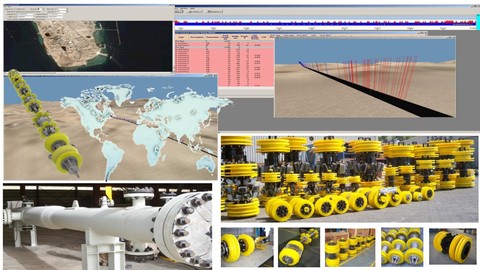
Pigging and ILI Inspection for Oil Gas Pipe line
Pigging and ILI Inspection for Oil Gas Pipe line, available at $44.99, has an average rating of 4.5, with 15 lectures, based on 1 reviews, and has 5 subscribers.
You will learn about what's pigging & why we pig a pipeline types of pigs , piggable pipeline, pig selection in-line inspection (ILI) tool , specification , verification and result validation Examples for Super High Resolution / Plus MFL &High Level Metal Loss Inspection TOOLS –UT This course is ideal for individuals who are oil and gas operator , engineers , beginner , student, technologist or mangers, Technicians, Chemical and petroleum industry specialists It is particularly useful for oil and gas operator , engineers , beginner , student, technologist or mangers, Technicians, Chemical and petroleum industry specialists.
Enroll now: Pigging and ILI Inspection for Oil Gas Pipe line
Summary
Title: Pigging and ILI Inspection for Oil Gas Pipe line
Price: $44.99
Average Rating: 4.5
Number of Lectures: 15
Number of Published Lectures: 15
Number of Curriculum Items: 15
Number of Published Curriculum Objects: 15
Original Price: $109.99
Quality Status: approved
Status: Live
What You Will Learn
- what's pigging & why we pig a pipeline
- types of pigs , piggable pipeline, pig selection
- in-line inspection (ILI) tool , specification , verification and result validation
- Examples for Super High Resolution / Plus MFL &High Level Metal Loss Inspection TOOLS –UT
Who Should Attend
- oil and gas operator , engineers , beginner , student, technologist
- mangers, Technicians, Chemical and petroleum industry specialists
Target Audiences
- oil and gas operator , engineers , beginner , student, technologist
- mangers, Technicians, Chemical and petroleum industry specialists
Pipeline Pigging refers to the practice of using devices or implements known as ‘pigs’ to perform various cleaning, clearing, maintenance, inspection, dimensioning, process and pipeline testing operations on new and existing pipelines. For existing operational pipelines pigging is normally performed without stopping the flow of the product in the pipeline. The ‘pigs’ can be of differing materials and configurations such Polyurethane Open Cell Foam, Cast Polyurethane and Rubber.
There are some hypotheses for why the process is called ‘pipeline pigging’, though none have been confirmed. One theory states that in the past, a leather-bound tool was sent through the pipeline, making the sound of a squealing pig as it passed through. Another theory is that after opening a pig trap, the tool lies in a pile of mud, in the same way a pig does.
Pipeline operators, service providers, and the regulatory community continually strive to improve the safety and
integrity of gas and liquid pipelines. In-line inspection of pipelines is a key technology utilized by the industry to help
maintain systems safety and integrity. In-line Inspection (ILI) really began in the 1960s with the introduction of a tool for corrosion measurement based on magnetic-flux-leakage technology. Today there are over 30 different tools in use by more than a dozen companies providing ILI services.
Course Curriculum
Chapter 1: Introduction
Lecture 1: Introduction
Chapter 2: what is pigging
Lecture 1: what is pigging
Lecture 2: why we pig a pipeline part1
Lecture 3: why we pig a pipeline part2
Chapter 3: Types of pigs
Lecture 1: types of pigs
Lecture 2: piggable pipelines
Lecture 3: Pig launcher and receiver design part1
Lecture 4: Pig launcher and receiver design part2
Lecture 5: pigging procedure
Chapter 4: ILI inspection
Lecture 1: ILI inspection tool part 1
Lecture 2: Ili inspection part 2
Lecture 3: ILI inspection validation and verification
Lecture 4: Geometry caliper tool
Lecture 5: metal loss inspection smart pigs part1
Lecture 6: metal loss inspection smart pigs part2
Instructors
-
Amr Saad Elsayed Ghazal
A Chemical Engineer work as an Integrity Dep. Head (staff)
Rating Distribution
- 1 stars: 0 votes
- 2 stars: 0 votes
- 3 stars: 0 votes
- 4 stars: 1 votes
- 5 stars: 0 votes
Frequently Asked Questions
How long do I have access to the course materials?
You can view and review the lecture materials indefinitely, like an on-demand channel.
Can I take my courses with me wherever I go?
Definitely! If you have an internet connection, courses on Udemy are available on any device at any time. If you don’t have an internet connection, some instructors also let their students download course lectures. That’s up to the instructor though, so make sure you get on their good side!
You may also like
- Top 10 Language Learning Courses to Learn in November 2024
- Top 10 Video Editing Courses to Learn in November 2024
- Top 10 Music Production Courses to Learn in November 2024
- Top 10 Animation Courses to Learn in November 2024
- Top 10 Digital Illustration Courses to Learn in November 2024
- Top 10 Renewable Energy Courses to Learn in November 2024
- Top 10 Sustainable Living Courses to Learn in November 2024
- Top 10 Ethical AI Courses to Learn in November 2024
- Top 10 Cybersecurity Fundamentals Courses to Learn in November 2024
- Top 10 Smart Home Technology Courses to Learn in November 2024
- Top 10 Holistic Health Courses to Learn in November 2024
- Top 10 Nutrition And Diet Planning Courses to Learn in November 2024
- Top 10 Yoga Instruction Courses to Learn in November 2024
- Top 10 Stress Management Courses to Learn in November 2024
- Top 10 Mindfulness Meditation Courses to Learn in November 2024
- Top 10 Life Coaching Courses to Learn in November 2024
- Top 10 Career Development Courses to Learn in November 2024
- Top 10 Relationship Building Courses to Learn in November 2024
- Top 10 Parenting Skills Courses to Learn in November 2024
- Top 10 Home Improvement Courses to Learn in November 2024






















